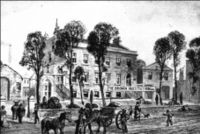Brown Institution
The Brown Animal Sanatory Institution (1871-1944) was a remarkable, but short-lived and now largely forgotten veterinary center of research and clinical practice. As well as providing a broad-based clinical service for the surrounding area of London, the Brown Institution was also the home of some of the most distinguished contributors to comparative medicine and physiology.
Origins
The Institution arose from a charitable trust under the will of Thomas Brown. Brown, about whom very little is known, was said to have been a lawyer, although there is little evidence to support his association with either the legal profession or the city of London. What is clear however, are the very specific terms of his will and the use to which £20,000 left to the University of London were to be put. Initially, the money was to be invested for 15 years, after which time the accumulated sum was to be spent within 4 years on "founding establishing and upholding an institution for investigating, studying and, without charge beyond immediate expenses, endeavouring to cure maladies, distempers and injuries any quadrupeds or birds useful to man may be found subject to."
Early Years
The institution's first professor-superintendent was Sir John Burdon-Sanderson, who also provided a significant financial contribution for purchasing the land on which the institution was built. Because of the involvement of Burdon-Sanderson, and his medically-trained colleagues, there was, prior to the opening of the Brown Institution, a subtle shift in the emphasis in its objectives towards comparative pathology and especially diseases that would have a direct bearing on the well-being on human health.
As a research center for comparative pathology, this was the first such institution of its kind created in the UK, and in many ways it served as a forerunner for the more celebrated Pasteur Institute in Paris and a similar establishment founded by Robert Koch in Berlin, that were to emerge in the following decades.
